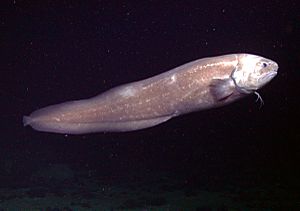Cusk-eel facts for kids
Quick facts for kids Cusk-eel |
|
|---|---|
 |
|
| Pudgy cusk-eel (Spectrunculus grandis) | |
| Scientific classification |
|
| Kingdom: | Animalia |
| Phylum: | Chordata |
| Class: | Actinopterygii |
| Order: | Ophidiiformes |
| Suborder: | Ophidioidei |
| Family: | Ophidiidae Rafinesque, 1810 |
| Subfamilies | |
|
See text |
|
Cusk-eels are a family of bony fishes called Ophidiidae. They live in the ocean and are part of a larger group called Ophidiiformes. Their scientific name, Ophidiidae, comes from the Greek word ophis, which means "snake". This is because cusk-eels look a bit like eels.
However, cusk-eels are not "true eels." True eels are a different type of fish. Cusk-eels are actually more closely related to fish like tuna, perch, and seahorses.
Contents
Where Cusk-Eels Live
Cusk-eels can be found all over the world. They live in both warm (tropical) and cooler (temperate) parts of the ocean. These fish usually stay close to the ocean floor. They can be found in shallow waters or in the deepest parts of the ocean.
One special cusk-eel, Abyssobrotula galatheae, holds a record. It was found at the very bottom of the Puerto Rico trench. This makes it the deepest fish ever recorded, living at an amazing 8,370 meters (27,460 feet) deep!
How Cusk-Eels Live
Most cusk-eels like to be alone. They are often found hiding when they are not looking for food. They like to hide in muddy areas or in large structures. These can include caves, cracks in coral, or groups of animals living on the seafloor.
Some cusk-eels are even more secretive. They live inside other animals! These are called parasitic cusk-eels. They can live inside oysters, clams, or sea cucumbers.
Cusk-eels usually hunt for food at night. They eat small animals without backbones, like crustaceans. They also eat other small fish that live on the bottom.
What Cusk-Eels Look Like
Cusk-eels have long, thin bodies. They are about 12 to 13 times longer than they are deep. The biggest cusk-eel species is Lamprogrammus shcherbachevi. It can grow up to 2 meters (6.6 feet) long. But most cusk-eels are shorter than 1 meter (3.3 feet).
Their back fin (dorsal fin) and bottom fin (anal fin) usually connect. They join with the tail fin (caudal fin). This makes a long, ribbon-like fin around the back of their body. Sometimes, the tail fin is just a small, fleshy or bony point.
Cusk-eels have pectoral fins that are longer than their head. Unlike true eels, cusk-eels have special fins under their mouth. These are called ventral fins. They look like a forked, whisker-like organ called a barbel. True eels usually don't have these fins at all.
Cusk-eels also have large mouths. Their upper jaw goes past their eye. They have two nostrils on each side of their head. Some cusk-eels do not have fish scales. If they do have scales, they are very small.
Reproduction
Cusk-eels lay eggs. This means they are oviparous. This is different from some of their close relatives, like the viviparous brotulas, which give birth to live young.
We don't know all the details about cusk-eel eggs. Scientists think they might lay single eggs that float freely in the water. Or, they might lay their eggs in a sticky raft that floats for a few days. After a few days, the eggs hatch into tiny cusk-eel larvae.
These larvae live near the water's surface with other tiny floating organisms called plankton. Scientists believe the larvae can control when they change into adult cusk-eels. This helps them travel further. It also helps them find new places to live where there isn't as much competition for food and space.
Conservation Status
Some cusk-eel species are caught for food. The pink cusk-eel (Genypterus blacodes) is one example. A few species in the larger Ophidiiformes group are considered vulnerable. However, we don't have enough information about cusk-eels as a whole. Because of this, we can't say if they are in danger or not.
Genera
The cusk-eel family has about 240 species. These species are grouped into 50 different genera: Subfamily Brotulinae
- Genus Brotula – typical brotulas
Subfamily Brotulotaenilinae
- Genus Brotulotaenia
Subfamily Neobythitinae
- Genus Abyssobrotula
- Genus Acanthonus – boney-eared assfish
- Genus Alcockia
- Genus Apagesoma
- Genus Barathrites
- Genus Barathrodemus
- Genus Bassogigas
- Genus Bassozetus
- Genus Bathyonus
- Genus Benthocometes
- Genus Dannevigia – Australian tusk
- Genus Dicrolene
- Genus Enchelybrotula
- Genus Epetriodus – needletooth cusk
- Genus Eretmichthys
- Genus Glyptophidium
- Genus Holcomycteronus
- Genus Homostolus – filament cusk
- Genus Hoplobrotula
- Genus Hypopleuron – whiptail cusk
- Genus Lamprogrammus
- Genus Leptobrotula
- Genus Leucicorus
- Genus Luciobrotula
- Genus Mastigopterus
- Genus Monomitopus
- Genus Neobythites
- Genus Neobythitoides
- Genus Penopus
- Genus Petrotyx
- Genus Porogadus
- Genus Pycnocraspedum
- Genus Selachophidium – Gunther's cusk-eel
- Genus Sirembo
- Genus Spectrunculus
- Genus Spottobrotula
- Genus Tauredophidium
- Genus Typhlonus
- Genus Ventichthys – East-Pacific ventbrotula
- Genus Xyelacyba
Subfamily Ophidiinae
- Genus Cherublemma – black brotula
- Genus Chilara – spotted cusk-eel
- Genus Genypterus
- Genus Lepophidium
- Genus Menziesichthys
- Genus Ophidion
- Genus Otophidium
- Genus Parophidion
- Genus Raneya – banded cusk-eel
Gallery
See also
 In Spanish: Ofididos para niños
In Spanish: Ofididos para niños


